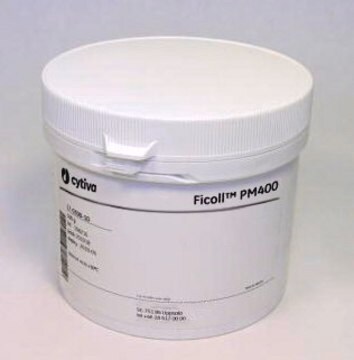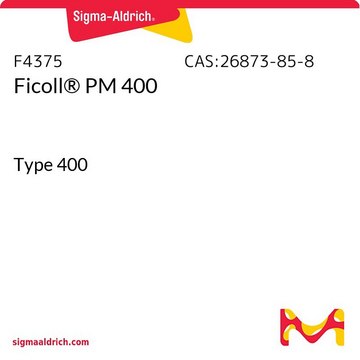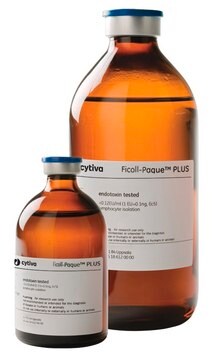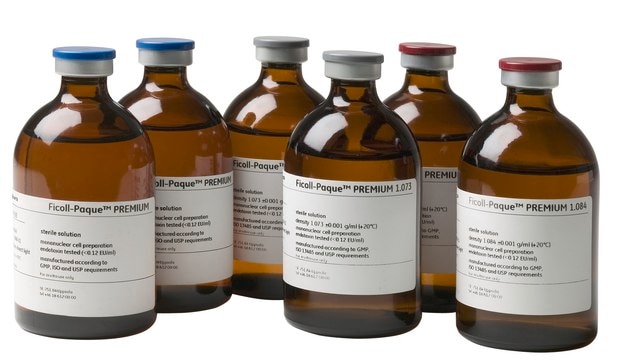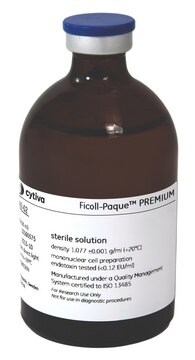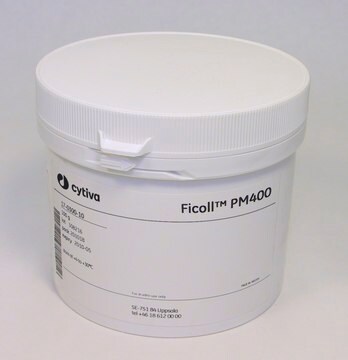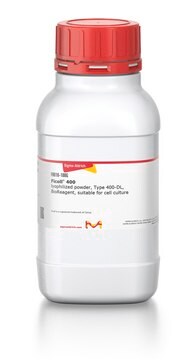GE17-0300-05
Ficoll® PM400
Cytiva 17-0300-05, pack of 5 kg
About This Item
Recommended Products
form
solid
spray-dried
packaging
pack of 5 kg
manufacturer/tradename
Cytiva 17-0300-05
color
White
solubility
soluble
General description
Ficoll® PM400 is a synthetic neutral, highly-branched hydrophilic polymer of sucrose with an average molecular weight of 400 000. It has long been used to form density gradients for separating and isolating eukaryotic cells, organelles and bacterial cells, as a stabilizing agent, and as a preparation medium for isolating mononuclear cells. Applications can also be found in defined culture media, nucleic acid hybridization, electrophoresis, and immunological studies.
Application
It also has applications in defined culture media, nucleic acid hybridization, electrophoresis, and immunological studies.
Used for gradient centrifugation in all types of centrifuge rotors and for separation at unit gravity.
Features and Benefits
- For producing density gradients for separation of cells and subcellular components by centrifugation or by sedimentation at unit gravity.
- Neutral, highly branched, hydrophilic polymer of sucrose which dissolves readily in aqueous solution.
- Concentrations of up to 50% (w/v) covering densities of up to 1.2 g/mL can be achieved.
- Better osmotic properties than sucrose.
- Preserves functional and morphological integrity.
- Useful for separating cells that are sensitive to centrifugation and for separating cells of similar density but different size (under conditions of sedimentation at unit gravity).
- Does not penetrate biological membranes.
- Serves as the raw material for preparation of Ficoll-Paque gradients.
- Used in other applications such as electrophoresis, hybridization, cryopreservation, and as a hapten carrier.
Storage and Stability
Analysis Note
Legal Information
Storage Class Code
13 - Non Combustible Solids
Certificates of Analysis (COA)
Search for Certificates of Analysis (COA) by entering the products Lot/Batch Number. Lot and Batch Numbers can be found on a product’s label following the words ‘Lot’ or ‘Batch’.
Already Own This Product?
Find documentation for the products that you have recently purchased in the Document Library.
Customers Also Viewed
Articles
This page shows methods to remove Percoll from a sample after centrifugation.
The effects of the mononuclear cell separation method described by Bøyum procedure are noted below, since research situations may arise in which they are significant.
The table was compiled to assist the researcher in selecting references most likely to contain relevant information regarding use of Percoll in various cell types.
Density Marker Beads are dyed derivatives of Sephadex™. There are ten color-coded bead types, each with a specific density. They have been specifically formulated for use in Percoll gradients and will not work with other media. Using Density Marker Beads as an external marker facilitates monitoring of the gradient shape and range.
Protocols
The following procedure has been evaluated with Ficoll-Paque PLUS and is recommended for separation of normal blood samples for maximum reproducibility.
How to use percoll to prepare a gradient
Related Content
Data was compiled to assist the researcher in selecting references most likely to contain relevant information regarding use of Percoll for a particular cell or tissue type.
Our team of scientists has experience in all areas of research including Life Science, Material Science, Chemical Synthesis, Chromatography, Analytical and many others.
Contact Technical Service